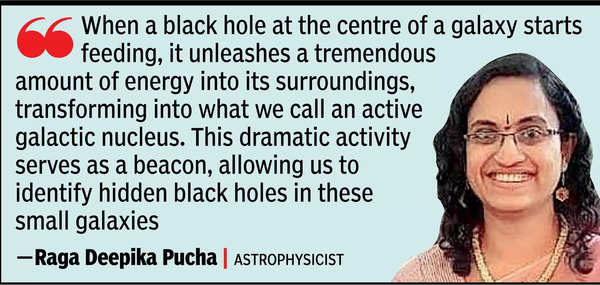VIJAYAWADA: A team of scientists in the United States, led by Indian origin astrophysicist Raga Deepika Pucha, have uncovered the largest samples ever of intermediate-mass black holes and dwarf galaxies hosting an active black hole.
The samples, said to be more than three times the existing census of black holes and dwarf galaxies, will allow for more in-depth studies on the dynamics between dwarf galaxy evolution and black hole growth.

It can also open up vast discovery potential surrounding the evolution of the universe’s earliest black holes.
Raga Deepika’s parents reside in Tenali town of Guntur district in Andhra Pradesh.
Using early data from the Dark Energy Spectroscopic Instrument (DESI), Deepika’s team compiled the largest sample ever of dwarf galaxies that host an actively feeding black hole, as well as the most extensive collection of intermediate-mass black hole candidates to date.
The dual achievement not only expands scientists’ understanding of the black hole population in the universe but also sets the stage for further explorations regarding the formation of the first black holes to form in the universe and their role in galaxy evolution.
According to a communication released by NoirLab, DESI is a state-of-the-art instrument that can capture light from 5,000 galaxies simultaneously. It was constructed, and is operated, with funding from the US dept of energy (DOE), office of science. DESI is mounted on the US National Science Foundation (NSF) Nicholas U Mayall at the NSF Kitt Peak national observatory.
Project to survey 40 mn galaxies, quasars
The program is now in its fourth of five years surveying the sky and is set to observe roughly 40 million galaxies and quasars by the time the project ends.
DESI project is an international collaboration of more than 900 researchers from over 70 institutions around the world and is managed by DOE’s Lawrence Berkeley National Laboratory.
With DESI’s early data, which include survey validation and 20% of the first year of operations, the team, led by University of Utah postdoctoral researcher Deepika, was able to obtain an unprecedented dataset that includes the spectra of 410,000 galaxies, including roughly 115,000 dwarf galaxies – small, diffuse galaxies containing thousands to several billions of stars and very little gas. This extensive set would allow Deepika and her team to explore the complex interplay between black hole evolution and dwarf galaxy evolution.
While astrophysicists are fairly confident that all massive galaxies, like our milky way, host black holes at their centers, the picture becomes unclear when moving toward the low-mass end of the spectrum. Finding black holes is a challenge in itself, but identifying them in dwarf galaxies is even more difficult, owing to their small sizes and the limited ability of current instruments to resolve the regions close to these objects, says Pucha. An actively feeding black hole, however, is easier to spot.
“When a black hole at the center of a galaxy starts feeding, it unleashes a tremendous amount of energy into its surroundings, transforming into what we call an active galactic nucleus. This dramatic activity serves as a beacon, allowing us to identify hidden black holes in these small galaxies,” Deepika explained.
The team identified 2,500 candidate dwarf galaxies hosting an active galactic nucleus (AGN) – the largest sample ever discovered. The significantly higher fraction of dwarf galaxies hosting an AGN (2%) relative to previous studies (about 0.5%) is an exciting result and suggests scientists have been missing a substantial number of low-mass, undiscovered black holes.





